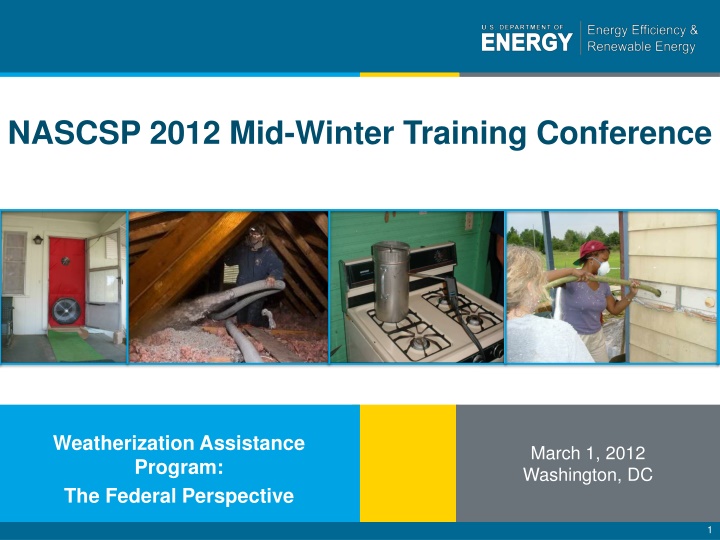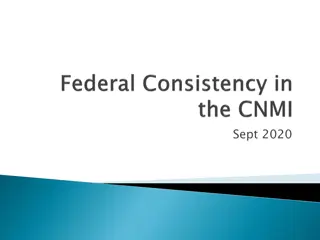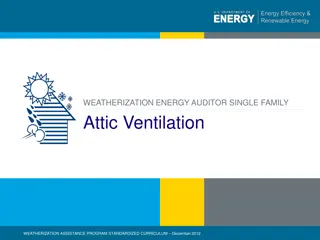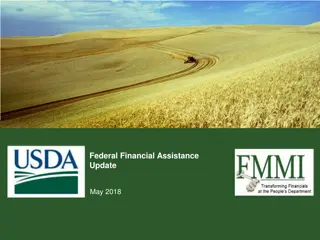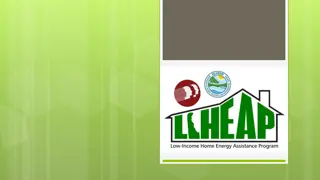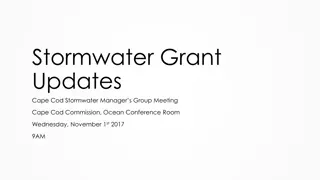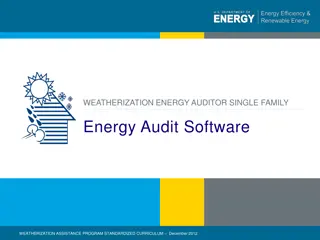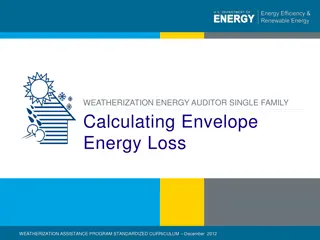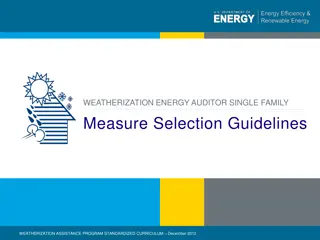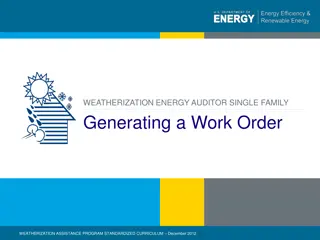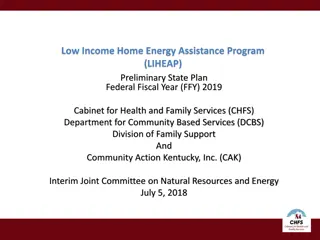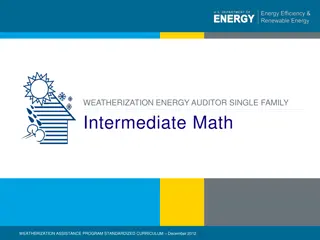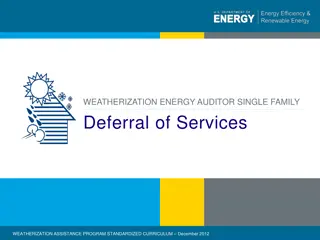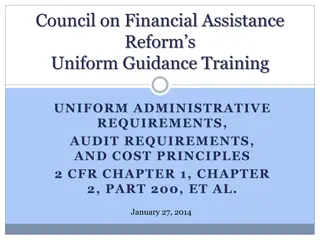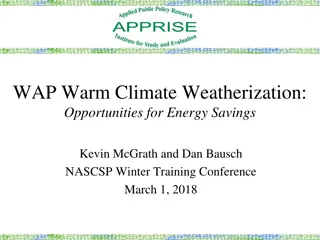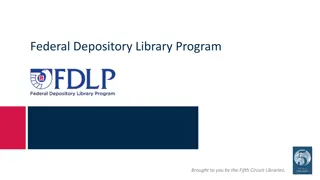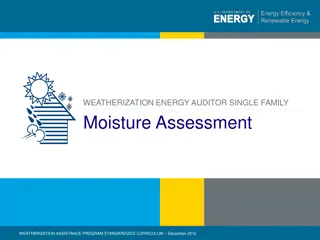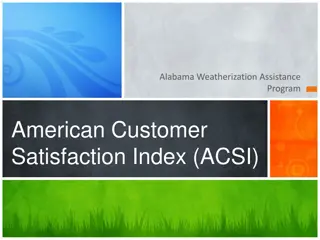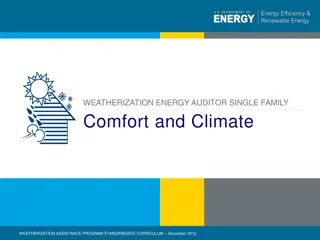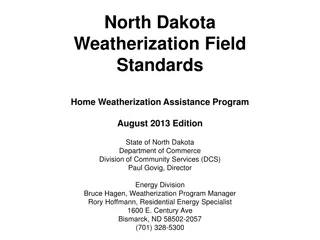Overview of Weatherization Assistance Program: Federal Perspective 2012
Highlights from the NASCSP 2012 Mid-Winter Training Conference focusing on the Weatherization Assistance Program (WAP) from a federal perspective. Topics include status updates on Recovery Act, 2012 Allocations, cost savings, job creation, program achievements, and future funding strategies.
Download Presentation

Please find below an Image/Link to download the presentation.
The content on the website is provided AS IS for your information and personal use only. It may not be sold, licensed, or shared on other websites without obtaining consent from the author.If you encounter any issues during the download, it is possible that the publisher has removed the file from their server.
You are allowed to download the files provided on this website for personal or commercial use, subject to the condition that they are used lawfully. All files are the property of their respective owners.
The content on the website is provided AS IS for your information and personal use only. It may not be sold, licensed, or shared on other websites without obtaining consent from the author.
E N D
Presentation Transcript
NASCSP 2012 Mid-Winter Training Conference Weatherization Assistance Program: The Federal Perspective March 1, 2012 Washington, DC 1
WAP Management Staff Presented by: Bob Adams Bob Adams, Program Lead/Supervisor Erica Burrin, Team Lead Monitoring and Field Operations Holly Ravesloot, Team Lead Policy and Communications Jennifer Somers, Team Lead Training and Technical Assistance Carole Gates, Branch Chief Rob DeSoto, Branch Chief Scott Reinecke, Branch Chief 2
Topic Areas Presented by: Bob Adams Status of Recovery Act Recovery Act Closeout 2012 Allocations Weatherization Plus 2012 Application Process Status of T&TA Initiatives Health & Safety National Evaluation Recovery Act Modification Multi-Family Weatherization Grant Transfer Process 3
Status of Recovery Act Presented by: Bob Adams and Adam Guzzo Production Spending 650,000 homes weatherized Max: 32,397 homes (Dec. 2011) Min: ~6 homes (April 2009) Now: 23,315 homes (Jan 2012) $4.18 billion spent Max:$196.97 million (Dec. 2010) Min: $2.98 million (April 2009) Now: $127.26 million (Jan. 2012) 165,000 multi-family units completed 25% of total production Jobs Supported Energy and Cost Savings1 2nd largest job creator in entire Recovery Act portfolio 13,230 jobs supported in Q4 of 2011 $6.66 billion in energy cost savings* $348.82 million saved annually 377 million MBtus in heating and cooling energy savings* 18.85 million MBtus saved annually *These figures represent savings over the 20 year life of the measures. Cost savings are expressed in 2008 dollars. 1Source: Oak Ridge National Laboratory TM-2010/66 (http://weatherization.ornl.gov/pdfs/ORNL_TM-2010-66.pdf) 4
2012 Allocations Presented by: Bob Adams and Adam Guzzo In the 2012 Consolidated Appropriations Act, Congress provided $65 million for allocation to WAP grantees Congress also provided the Secretary of Energy with the authority in PY 2012 to use a methodology other than the formula established in regulation to distribute the available funding The Secretary exercised that authority and the resulting PY 2012 allocation is intended to create WAP funding in PY 2012 comparable to funding levels prior to the American Recovery and Reinvestment Act of 2009 (ARRA). The PY 2012 allocation uses a results oriented strategy that considers remaining fund balances grantees may have from the ARRA and prior year DOE Appropriations to distribute the Fiscal Year (FY) 2012 WAP Appropriations 5
2012 Allocations Presented by: Bob Adams and Adam Guzzo DOE allocated PY 2012 funds to ensure two major outcomes: 1) grantees that spent their ARRA funds on time have adequate DOE funding to maintain their operations at pre ARRA levels; and 2) all grantees have adequate funds to operate throughout PY 2012, given the fund balances that are already allocated but remain unspent The 2012 Allocation was based on the following criteria: Use of an appropriation amount of $210 million as the base PY12 Target Allocation for establishing funding for each grantee Whether a significant portion of the PY12 Target Allocation is available in ARRA balances for at least half of a grantee s PY 2012 PY 2012 Target Allocations were adjusted downward by 25 percent for grantees with such significant balances 6
2012 Allocations Presented by: Bob Adams and Adam Guzzo The 2012 Allocation criteria (continued): Whether more than the PY12 Target Allocation (adjusted for ARRA balance as described on previous slide) is expected to be available at the start of a grantee s PY 2012 Grantees with a prior year balance totaling more than the PY12 Target Allocation did not receive additional FY 2012 funding Whether more than 60 percent of the PY12 Target Allocation (adjusted for ARRA balance as described above) is expected to be available at the start of a grantee s PY 2012 Target Allocations were adjusted downward by 50 percent for these grantees Allocation of PY 2012 funds was provided to those grantees requiring additional DOE funds to reach their adjusted PY12 Target Allocation This allocation was equal to 76.38 percent of the adjusted Target Allocation - the proportional share of the $65 million Appropriation relative to the sum of the adjusted target allocations 7
2012 Application Process Presented by: Erica Burrin Each Grantee will submit a 2012 Plan Those Grantees with new 2012 Allocations will submit a new State Plan Application through Grants.gov and the PAGE online system Those Grantees without 2012 Allocations will submit a revised State Plan Application through PAGE only. The Application should include an SF-424 Application, Budget, Budget Justification, Annual File, and Master File. These elements should be entered as an amendment to the existing grant in the PAGE online system The WAP formula grants with project periods scheduled to end in 2012 are anticipated to have the grant period extended one year, regardless of whether the grantee received an allocation of new 2012 funds 8
Health and Safety Presented by: Ryan Middleton Required as part of the 2012 application Must fully incorporate WPN 11-6 ASHRAE must be implemented to the fullest extent possible Those grantees unable to fully perform ASHRAE 62.2 must provide in their 2012 H&S Plan an implementation strategy including Which components will be implemented in the field for 2012 Why they are not prepared (lack of training, not enough time, etc.) How they will get prepared (more training, phasing in, etc.) When they plan to meet full compliance, no later than PY 2013 ASHRAE 62.2 cannot be altered without scientific support and justification provided in the H&S Plan and approved by DOE 9
Recovery Act Modification Presented by: Erica Burrin Final concurrence on the requests provided by HQ - 1/6/12 Project Officers (POs) to contact grantees to authorize submission of modifications through PAGE 1/9/12 POs should have the technical review of modifications completed by 3/1/12 Contract Officers at NETL to approve modifications by 3/31/12 10
Grant Transfer Process Presented by: Erica Burrin Grant Transfer from NETL to Golden Field Office Procurement Grants will be transferred in batches First batch transferred by 2/24/2012 First batch includes 27 WAP Formula Grants with April 1 start date Second batch of remaining 32 WAP Formula Grants transferred in April Most ARRA WAP Grants (including WAP Training Center Grants) will be transferred in March or April 11
Grant Transfer Process Presented by: Erica Burrin Grant Transfer Actions General notification letter sent to all grantees Second letter sent prior to each batch of grant transfers Second letter provides details: Date of transfer, ASAP account procedures, blackout period for ASAP draws ASAP blackout period 5 days (or several weeks if grantee has not established Golden ASAP account) Grantees may draw advance prior to blackout for projected needs 12
Recovery Act Closeout Presented by: Bob Adams, Holly Ravesloot, and Greg Reamy Guidance Closeout Guidance WPN 12-3 FAQs http://www1.eere.energy.gov/wip/pdfs/wap_closeout_faqs.pdf Searchable Database http://www1.eere.energy.gov/eere_faq/default.aspx?pid=10 - Additional Questions Open discussion 13
Weatherization Plus Presented by: Bob Adams Current Effort Brainstorming Webinars Communications and Messaging January 25th Leveraging February 8th Consistent Delivery of Quality Services February 22nd New Markets and Existing Potential March 7th Face to Face Meeting March 20-21st Strategic Situation Analysis Establish Subcommittees and Plan Priorities Develop Subcommittee Work Schedule and Assignments Strategic Plan Finalized June, 2012 14
Status of T&TA Initiatives Presented by: Jennifer Somers Weatherization: The Roots of the Home Performance Industry Consistent funding gives the WAP the ability to take on long term projects and partnerships that support the entire industry. Audit Tools Lab Research Building Science Case Studies Training Network Coordination with Federal agencies: HUD, EPA, USDA Leveraging WAP has always been the catalyst. The consistent source of resources that allows other opportunities to grow 15
WAP Investing in the Future DOE invested nearly $139 million in technical assistance to lay the foundation for high quality energy upgrades in America s homes. The Guidelines for Home Energy Professionals: The technical experts of the Weatherization Assistance Program, together with NREL and partners from across the home performance industry are creating a suite of resources that will become the standard for success nationwide Standard Work Specifications (SWS) Single Family Mobile Home Multifamily Housing Training Program Accreditation Accreditation of Energy Efficiency Training Programs based on the JTAs is fully operational Worker Certifications 16
WAP Investing in the Future WAP invested in 26 new training centers and now has 39 training centers operating in 29 states National Weatherization Training Portal (NWTP): virtual campus enhances and supplement traditional classroom, lab, and in-field weatherization training, covers basic and advanced building science. National Training & Education Resource (NTER) was designed to help the Weatherization program train workers fast and efficiently but for sustainability purposes was engineered to support a wide variety of training needs. It is currently being used across EE/RE, DOE, federal agencies, colleges, universities and international organizations. The WAP Standardized Training Curriculum Weatherization Plus Health H&S Specific Training Priority Areas 17
Weatherization Plus Health The U.S. Department of Energy's (DOE) Weatherization Plus Health initiative is a national effort to comprehensively and strategically coordinate resources to improve the energy efficiency, health, and safety of low-income homes. Weatherization Plus Health ensure energy efficient and healthy indoor environments by facilitating the establishment of strong, effective partnerships between DOE's Weatherization Assistance Program (WAP) and healthy homes providers. The National Association for State Community Services Programs (NASCSP) is implementing the project on behalf of DOE. KEY DELIVERABLES: Regional Conferences WeatherizationPlusHealth.org Wx & HH Reports for each Grantee Grantee Implementation of Wx Plus Health Best Practices for Referral Systems Training and Technical Assistance 18
WAP Investing in the Future Multifamily Energy Audit Tool Version 1 - simpler buildings & systems, few extras Low-rise, up to four floors, separate treatment of corner and interior units, first and top floors Individual dwelling unit space conditioning systems Both dwelling unit and central-plant domestic hot water systems Version 2 - more complex buildings & systems, additional capabilities High-rise with service core (elevators, etc.) Central plant with built-up space conditioning systems More complex measures, rules-based savings M U L T I P L E B L O C K S 19
WAP Investing in the Future Multifamily Energy Audit Tool: Existing Timeline Time Fall 2011 Winter Spring Summer Fall 2012 Winter Spring Summer Version 1 BETA Version 2 BETA Final Version 1 Final Version 2 Version NEAT: web-based ~ High-rise ~ Built-up central systems ~ Rules-based measures ~ Low-rise walkups ~ Individual HVAC ~ Central or individual hot water Features Pilot test v1 Pilots Pilot v2 External input TAG Meeting TAG Meeting ACI: March 2011 ACI: March 2012 APIs available to third-party software developers Home Energy Saver MF functionality in HES GUIs 20
National Evaluation Status of the data collection Continued surveying of large multi-family buildings clients Continued surveying of crew chiefs and crew along with non-energy benefits study. Status of the Recovery Act evaluation Acquiring data from state weatherization program databases Projected Publication of Results Impact Reports - Study Final Report Process Reports - Study Final Report April 1 Program Characterization June 15 Field Process Auditor Survey Crew Chief Survey Crew Survey Occupant Survey June 1 May 1 July 15 July 1 July 1 August 1 August 1 September 1 Eligible Population Indoor Environmental Quality NonEnergy Benefits*** Mobile Homes Single Family Small Multi-Family Large Multi-Family Impact Report August 1 July 15 21
Questions? Questions? 22
